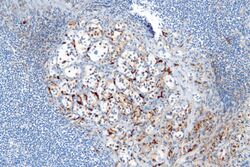Biology:Sustentacular cell
From HandWiki
Short description: Structural and metabolic support cell

Micrograph highlighting the sustentacular cells in a paraganglioma. S100 immunostain
A sustentacular cell is a type of cell primarily associated with structural support, they can be found in various tissues.[1]
- Sustentacular cells of the olfactory epithelium (also called supporting cells or Sertoli cells) have been shown to be involved in the phagocytosis of dead neurons,[2] odorant transformation[3] and xenobiotic metabolism.[4]
- One type of sustentacular cell is the Sertoli cell, in the testicle. It is located in the walls of the seminiferous tubules and supplies nutrients to sperm.[5] They are responsible for the differentiation of spermatids, the maintenance of the blood-testis barrier, and the secretion of inhibin, androgen-binding protein and Müllerian-inhibiting factor.[citation needed]
- The organ of Corti in the inner ear and taste buds also contain sustentacular cells.[citation needed]
- Another type of sustentacular cell is found with glomus cells of the carotid and aortic bodies.[citation needed]
- About 40% of carcinoids have a scattering of sustentacular cells, which stain positive for S-100.[6]
References
- ↑ "Sustentacular cell - Biology-Online Dictionary | Biology-Online Dictionary". https://www.biology-online.org/dictionary/Sustentacular_cell.
- ↑ Suzuki, Yuko; Takeda, Masako; Farbman, Albert I. (1996). "Supporting cells as phagocytes in the olfactory epithelium after bulbectomy". Journal of Comparative Neurology 376 (4): 509–517. doi:10.1002/(sici)1096-9861(19961223)376:4<509::aid-cne1>3.0.co;2-5. ISSN 1096-9861. PMID 8978466.
- ↑ Heydel, Jean-Marie; Coelho, Alexandra; Thiebaud, Nicolas; Legendre, Arièle; Bon, Anne-Marie Le; Faure, Philippe; Neiers, Fabrice; Artur, Yves et al. (September 2013). "Odorant-Binding Proteins and Xenobiotic Metabolizing Enzymes: Implications in Olfactory Perireceptor Events: Odorant-Binding Proteins and Metabolizing Enzymes". The Anatomical Record 296 (9): 1333–1345. doi:10.1002/ar.22735. PMID 23907783.
- ↑ Zhuo, Xiaoliang; Gu, Jun; Behr, Melissa J.; Swiatek, Pam J.; Cui, Huadong; Zhang, Qing-Yu; Xie, Yingqiu; Collins, Doris N. et al. (February 2004). "Targeted Disruption of the Olfactory Mucosa-Specific Cyp2g1 Gene: Impact on Acetaminophen Toxicity in the Lateral Nasal Gland, and Tissue-Selective Effects on Cyp2a5 Expression". Journal of Pharmacology and Experimental Therapeutics 308 (2): 719–728. doi:10.1124/jpet.103.060301. ISSN 0022-3565. PMID 14610229.
- ↑ Jones, Richard E.; Lopez, Kristin H. (2014). "The Male Reproductive System". Human Reproductive Biology. pp. 67–83. doi:10.1016/B978-0-12-382184-3.00004-0. ISBN 978-0-12-382184-3.
- ↑ Burke, AP; Sobin, LH; Federspiel, BH; Shekitka, KM (November 1989). "Appendiceal carcinoids: correlation of histology and immunohistochemistry". Modern Pathology 2 (6): 630–7. PMID 2479945.
 |

